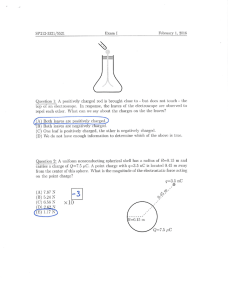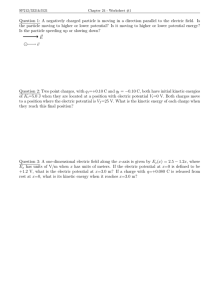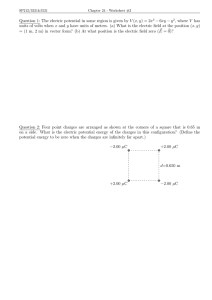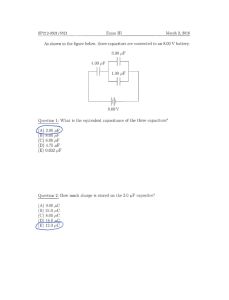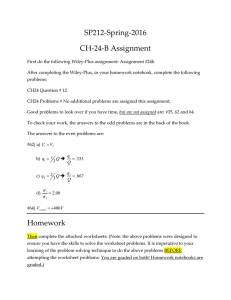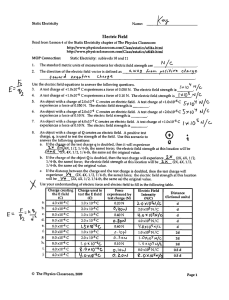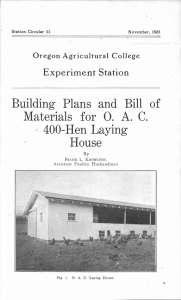Question 1: An electron with a velocity of u =...
advertisement
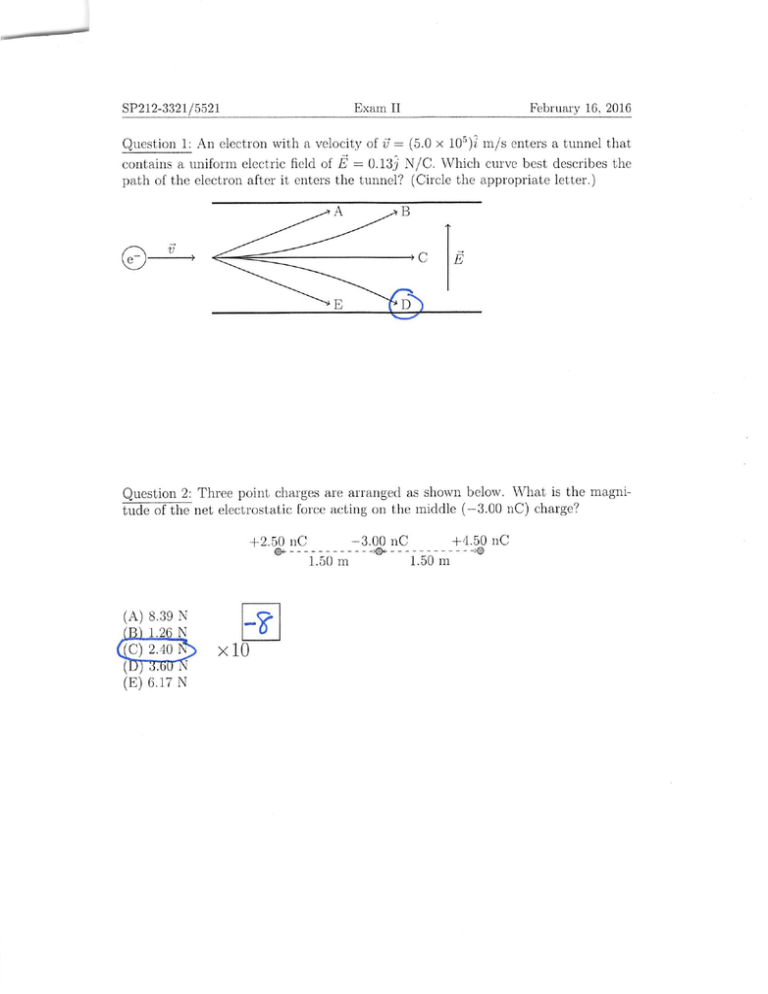
SP212-3321/5521
February 16, 2016
Exam II
Question 1: An electron with a velocity of u = (5.0 x 10''')2 m/s enters a tunnel that
contains a uniform electric field of E = 0.13j N/C. Which curve best describes the
path of the electron after it enters the tunnel? (Circle the appropriate letter.)
Question 2: Three point charges are arranged as shown below. Wliat is the magni
tude of the net electrostatic force acting on the middle (-3.00 nC) charge?
+2.50 nC
-3.00 nC
1.50 m
(A) 8.39 N
(B) 1.26 N
([C) 2.40
(D) 3.6U
(E) 6.17 N
xlO
+4.50 nC
^
>9
1.50 m
7
V
Noi^ohX -- A
zpN^.OiHLls] <-pt/ ^pi^iUT-J
U-)N,PHu-c
!(
— •
:)''s-),+
7"S-f+
\jOt|bjvJ -V
^«o<l
vin9|0 Cp.{o<j J o^
j»»Pjbi|0 Zj>i7j>^vr PJ'*' "rvioj^i®
1^'d [1»
SP212-3321/5521
Exam II
February 16, 2016
Question 3: Two concentric insulating hollow spheres are charged. The smaller
sphere, with radius /2]=0.12 m, has a total charge of Qi = —4.5 fuC distributed
evenly across it. The larger sphere, with radius R2=0.S6 m, has a total charge of
Q2 = +4.5 fiC distributed evenly across it. A point charge, with q = +1.0 ^C, is
placed at a position that is r=0.24 m from the center of the spheres. What is the
magnitude of the net electrostatic force acting on the point charge?
i?2=0-36 m
7.02^
{l^j 2.81 N
(C) 0.00 N
(D) 5.62 N
(E) 3.12 N
-1
Q2=+4.5 /iC
xlO
Question 4: A hollow spherical conductor carries a net charge of Q=—1 fiC. The hollow interior of the sphere contains a point charge of 9 = +3 fiC. How much charge
resides on the exterior surface of the conductor?
(A)
(B)
(C)
I))
-1 fiC
-0.5 /iC
+1 (iC
-3
% +2 /iC
Qi Cc(V\ )»e 4reJ-e«( <ts pei-ch cUrjc «if ••'b ce<Atr
Ql
ho hfcb elet/r.'c -force
CWxio'^)
" O.^oQH --
7.o:?x]o
A/
Nfl E~"^''*®icl ;>i siJe o«w ConJucLrno hcrf- C
1-^
Co*ycl^O^^^
i-X l^ojy
G<tU.ss:<ih S'^r^ct. ','\siJc ct^Joylv^' co^ibxi no
cUi^t
•=p ~3 fJiC OK Vfc^r SKr"f-ve of Ce-vJ'tC.'^^
-3/^C + (SeK+ - -ImC
^5aC
SP212-3321/5521
February 16, 2016
Exam II
Two point charges (-2.0 /iC and +4.0 }xC) are placed as shown.
y
-2.0
0.75 m
P
0.45 m
4.0 iiC
Question 5: What is the magnitude of the electric held at point P?
(A) 8.34 N/C
(B) 5.59 N/C
(C) 2.10 N/C xlO
P) 1.46iV/ff
(p) 1.80 N/^
Question 6: What is the electric potential at point P? (We'll define the potential to
be zero infinitely far away.)
(A) 1.46 V
(B) 1.04 V
'C) 7.62 V
1
xlO
A.OihS'S --A
AooLSS = 1.^01 U£>(.Aotitc
-A
V.
^ OlxOj^'l =2oooo^l -.3
^ OoQoi/ »
0\i%onil)f^ -' ^3^^- 3
c Oistti - IC)
pinu) •'3
^oniz- --uo
a'3
-) "D
V
^ ^
• -jvr-
(sp
SP212-3321/5521
February 16, 2016
Exam II
Two point charges (+3.0 fiC and +4.0 /iC) are placed as shown, 0.90 m apart.
Point P is between the two charges, 0,60 m away from the 3.0 fiC charge.
0.30 m
0.60 m
3.0 /iC
P
+0 /iC
Question 7: What is the magnitude of the electric field at point P?
4.74
5) 3,25 N/C
(CJ 1.65 N/C xlO
(D) 7.49 N/C
(E) 4.07 N/C
Question 8; What is the electric potential at point P? (We'll define the potential to
be zero infinitely far away.)
^1.65 V
5
7.49
(C) 1.28 V
(D) 4.74 V
(E) 3.25 V
xlO
A0Oil<^1 .(.A O-igLTJ) - {AOSUh) jbp^^
>,
^,ohsn --^'"3
•J
r—
r~"
(v'-:* noi'iui • (JOiij^^oHi-i)-'3
i^ocui
-. '1
's
(A*
••3
SP212-3321/5521
February 16, 2016
Exam II
Question 9: Two very large nonconducting sheets of charge are parallel and separated
by a distance that is small in comparison to the size of either sheet. The left sheet
carries a uniform surface charge density of ai = +2.50 x 10"^ C/m^, while the right
sheet carries a uniform surface charge density of (T2 = —7.00 x 10"^ C/m^. What is
the magnitude of the electric field at point P, which is between the sheets?
(72 = -7.00 X 10"® C/m
I
rfj
I
>
•
. •'I
•• >
•}
ai = +2.50 X 10"® C/m'
(A) 1.07 N/C
<[B) 5.37 N/C)
{^2-54 N/U xlO
(D) 5.09 N/C
(E) 4.27 N/C
m
K
^ ^oiytis : ""3
3 ^ ifS =-*'"3
..
c
-
,2/l|
3
,r^^P'»u'ye ..-,
"'I -3
o|-
-I
^ *3
•t
•i
+
1
+
3
'3
+
•»•
'i»
(W
SP212-3321/5521
Exam II
February 16, 2016
Question 10: A cube that is 0.45 m on an edge is oriented with one corner at the
origin and three edges along the axes of a Cartesian coordinate system. The electric
field in this region of space is parallel to the s-axis. The electric field at the top of
the cube (at z=0.45 m) is E = +9.0k N/C. The electric field at the bottom of the
cube (at 2=0.0 m) is .E = +15fc N/C. How much net charge is contained within the
cube?
(A) 4.30 C
(B) -4.30 C
gXJJML
D) -1.08 Q
-11
xlO
(S) 5;51 c
(F) -5.31 C
Question 11: A circle with radius i?=0.45 m lies in the xy plane. A uniform electric
of E = (5.3f - 6.23 + 3.4fc) N/C passes through the circle. What is the magnitude
of the electric flux passing through the circle?
fAi 1.59 N-mVC
(fe) 2.16 N-mVCj
(C) 5.62 N-mVC
(D) 0.573 N-mVC
(E) 5.19 N-mVC
^
?; c
--
2C5A-£4c-?-its)-{,j| Ntw; - Vv3
V
V^
^
^
Ol^gO'T9
•T -T !
Cv.,P"S2's;(
sir:-;
0 ^/
x'^-N
'•"2
.^RSH =3 ivp
JIC'T- -
as;)j«ji,';-[Ri;.t'"si.';^
^K/i.+ -3 Vf
SP212-3321/5521
Exam II
February 16, 2016
Question 12: The electric field in some region is along the j-axis and given by
Ex = 1.7 + 2.2a:, where Ex is in N/C when x is in meters. If the electric poten
tial at a;=0 is defined to be 1.5 V, what is the electric potential at :r-2.0 m?
-6.3
(h)
(C) 9.3 V
(D) -7.8 V
(E) 7.8 V
Question 13: The electric potential in some region is given by V{x, y) = x^~3xy-2y'^,
where V has units of volts when x and y have units of meters. What is the electric
field at the position (x,y) = (1 m, 2 m)?
(A) (5i + 14j) N/C
jU + llj) N/O
(D) (-41 - 11?) N/C
(E) (-2-i +8ij N/C
(F) {2i - 8j) N/C
%TU 'IVh-'iVi '^3
c =(tK+(nc- ='3
i)
:(></,- X£.J- .•^_ ..Ag
Af
=
A^'^-
xf
-'*3 itifr
. i,
^AZ-£- AS1 -• A
A^'zi - --^'/U*l7 +*i'0- -• (AS'I)^f[n-C*i'07- -AA5-)j-^
SP212-3321/5521
February 16, 2016
Exam II
Three point charges, each +2.00 /iC, are arranged as shown below to complete
three corners of a square that is 0.500 m long on each side.
+2.00 mC
+2.00 /iC
d=0.500 m
+2.00 (iC
Question 14: What is the electrostatic potential energy when these three charges are
in this configuration? (We'll define the potential energy to be zero when the charges
arc infinitely far apart from each other.)
(A) -9.73 J
(B) 9.73 J
(C) -1.95_J
GP) 1.95J^
-I
xlO
(E) -leoj
(F) 3.60 J
Question 15: How much work must we do in order to move a fourth charge of
q = -3.00 fjC from infinitely far away to the empty corner of the square?
(A)
(B)
(C)
(D)
2.92 J
-2.92 J
5.39 J
-5.39 J
jF) 2.29.g.
^F)-2.29 T)
-1
xlO
.Srn
^
U^k
.5
\
olr<i^oh<i|"VC.5^.^1*+•6Sr,')^ *=.70? #1^
(t.iuio
Cr
/
Y
^
. 7o?-
- (o.o^JVZ)*(o.o^lti3> (o.osou 3)
U-- O.nsz ' 1.15'ld^ 3
V
«I5)
i5»^
fowf P
z', 70?*^
,5av
AU--
e
Corner
CQflo'^'c) I pxto'^'c) I (ixld^'c)
k
v^r- 5«^ k . 5
- ??3S0 V
= (-3fid c)f7?3S0V^ -O.ar^ J
Vie. fttvs,"!" io toofk ^t>
W'-0.01^3 --3.7;;'to'^3 j
SP212-3321/5521
February 16, 2016
Exam II
Question 16: Three points charges, with charge —2.0 /iC, —3.0 /iC, and 4-3.0 /iC,
occupy the corners of an equilateral triangle that is 0.55 m long on each side. If we
define the electrostatic potential energy to be zero when the charges are infinitely
far apart, what is the potential energ>' of the charges in this configuration?
Qi=-^.0 mC
CAl IA7 J
CB) -1.47 j>
(C)
(D)
(E)
(F)
2.67 J
-2.67 J
3.27 J
-3.27 J
-i
xlO
^ 'cf-
Q2=-3.0^C
g3-+3.o /iC
Question 17: A point charge with 5=—2.50 mC has kinetic energy A'i=0,5D0 J when
it is located at a position with an initial electric potential of Vi=0.00 V. The particle
moves to a position with a final electric potential of V}=50.0 V. The electrostatic
force is the only force acting on the particle. What is the particle's kinetic energy
when it reaches its final position?
(A) 0.125 J
(B) 0.375 J
(C) -0.125 J
(Tp 0.625 O
O.500 J
£ stro = £5cyo-*
£ srro -
(£ stro-J -
z')/-^)l 4 ^19-+^>1 -'n•+"!)(
p»-j3r^05
£ srro- - ')7- ^10
cssi'o- ttA0'05j('='j.p/*St-} •
Ul^
>M5s
>1
v«5 3.
k.S3-
(5,o/«£-;(Y<M»i;0
7, ^ -n
tp„pi>i)ip s»'t-)
'fhy-n iii»
SP212-3321/5521
Exam II
February 16, 2016
As shown in the figure below, three capacitors are connected to an 8.0 V battery.
6.0 fiF
8.0 /iF
~
8.0 V
Question 18; What is the equivalent capacitance of the three capacitors?
(A) 9.5
(B) 8.7 1/.F-
^C) 4.0
TnTTT^r
(E) 16 fiF
Question 19: How much charge is stored on the 8.0 /iF capacitor?
:b) 32 I^cj
jjynrjic
(D) 64 {iC
(E) 8.0 fiC
HHfW
—[HI—
^/aF-
I
^®l
'
S>P
. '
s>p
= I.OmP
i^ll)
l)«\'i' e^o't
' n.Oxio''P)C^.0V) ' 3QjuC
^fU'VUle^'^ Cq^t C'
Jcr/fj to-'H iwM JaiSc^
ejtilKles*)" ce.jff<iCikr
SP212-3321/5521
Exam II
February 16, 2016
"Question 20: A parallel plate capacitor consists of two square metallic plates, each
of which is 2.00 cm long on each side, that are separated by 2.50 mm. A material
with dielectric constant k fills the space between the two plates. When the capacitor
is fully charged by a 12.0 V battery, it will store 3.57 x 10""^° J of energy. What is
the value of «? [note: k is unitless.]
(A) 22.4
(B) 7.00
(C) 2.10
:D) 1.42.
}e) 3.50'
05'€ --X
OS'S
--X
V V >c
n
O
^{AO'cOd
A^ ^ -D
Y"^ X
jQ
